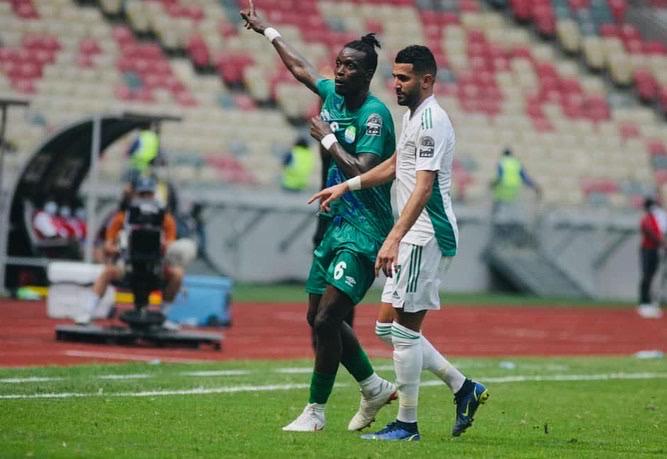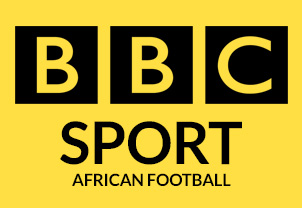John Kamara tussles with Riyad Mahrez in Leone Stars draw with Algeria in AFCON Cameroon 2021
Despite its huge popularity in Africa, soccer has a great untapped potential to transform Africa’s cultural and creative landscape.
By: Meron Demisse, Lincoln Ajoku
Soccer is not only the pre-eminent sport on the African continent but is the single greatest cultural unifier. Nothing else unites people from Ras ben Sakka in Tunisia to the Cape of Good Hope in South Africa like the round ball.
Casual players, professional athletes, online gamblers, fanatical supporters, tavern owners, sidewalk vendors, broadcasters, and journalists; an entire cultural ecosystem is built around the pursuit of goals.
For example, the Africa Cup of Nations (Afcon) 2021 was broadcast in over 157 countries, with a viewership of 65 million in Nigeria alone. The matches also gained high levels of engagement on various social media platforms such as TikTok, which garnered a whopping 2.5 billion views under the afcon2021 hashtag.
On days when soccer matches are played, towns and cities buzz with anticipation. Even when Africa is only tangentially connected, such as World Cup matches or Premier League competitions, the game leaves an indelible impression on the continent.
Soccer’s potential in Africa is huge
And yet there are still opportunities to make even more significant inroads, spurring economic activity through bolder linkages with local communities. Increased connections between soccer and the cultural and creative economy, which includes entertainment, the culinary world, fashion, the visual and performing arts, and tourism, will make the already dominant sport even more dynamic.
An example of this played out during the 2010 World Cup in South Africa—for the first time, this global celebration was staged on African soil—where the vuvuzela became a symbol of the event. Its popularity created a boom for manufacturers and became associated with the sport’s culture globally. The long plastic horn said to have once been used to galvanize members for communal meetings is now used globally, not only at soccer matches but at boisterous political rallies.
The possibilities are limitless and do not necessarily have a short shelf life. Nigeria’s triumph at the 1996 Olympic Games in Atlanta, US, is still celebrated in the country and beyond its borders. That win helped galvanize a fragmented nation. Though the overall contribution of sports (including soccer) and entertainment to Nigeria’s GDP was just 0.33% in 2021, new initiatives and investments are starting to change this trend—even attracting African startup founders. Demand for tickets to attend qualifying matches for Afcon has surged as interest in the sport grows in the country and across the region.
This broad appeal offers numerous opportunities for cultural and economic expansion. For instance, several African countries are currently participating in the launch of Africa’s Beach Soccer League. In May 2022, the Festival of African Culture (FESTAC) event in Zanzibar also included a beach soccer event as part of efforts to promote “African culture, values, and civilization.”
Additionally, in February, FIFA, the international soccer federation, organized the inaugural Africa School Champions Cup in Kinshasa, Democratic Republic of Congo, which involved teams from six African countries and brought together 12,000 youth to watch the matches.
Initiatives linking soccer to culture in Africa
But with soccer’s success in Africa, more investment can still be made to build a more robust soccer culture on the continent, and the Confederation of African Football (CAF), the continent’s governing body, has a critical role to play.
CAF’s influence can boost both women’s and men’s soccer through Africa-based leadership. This includes efforts to engage further with industries such as fashion, tourism, architecture, construction, agriculture, and entertainment. With the recent announcement of the Africa Super League, CAF president Patrice Motsepe says that the League aims to “change the face of African football” by improving the quality of the game but also emphasizing its cultural impact.
Taking the fashion industry as an example, the widespread popularity of Nigerian fashion at the 2018 World Cup included the country’s soccer kit, which sold out in retailers around the world. Soccer shirts are now an integral fashion consideration, and clubs and national teams are adjusting their designs and logos to shift with modern tastes. This in turn generates interest among consumers who might not have otherwise cultivated a love for the game.
Deliberate efforts should be made to improve supply chains by sourcing material locally, ensuring designers contribute to the design of the kits, and that manufacturing is done in countries on the African continent. Additionally, efforts should be stepped up to remove counterfeit kits from the market, given their negative impact on local designers and manufacturers.
Soccer infrastructure in Africa
Another area where soccer and local African cultures are intertwined is around the design and construction of stadiums. Much has been said about dilapidated arenas that are no longer suitable for hosting matches. Following the conclusion of this year’s women’s Africa Cup of Nations in Morocco, CAF announced a ban on 23 stadia across the continent from being used for international matches, including in Liberia, Mali, Namibia, and Uganda.
But this creates further opportunities for collaboration. Local artists can be brought in to help with the design of the refurbishment. These artists can draw on inspiration from indigenous and local influences and incorporate climate-resilient structures. This is a shot at a goal that must not be missed. For instance, the Soccer City Stadium in Soweto, South Africa, resembles a calabash and is a perfect example of what can happen when art, culture, and soccer are successfully interwoven.
The positive wins will make African countries an attractive tourist destination for fellow tourists from within the continent, which would spur regional integration and economic growth.
Deepening the synergy between soccer and the creative economy
There are also implications for boosting entertainment through a strategy of engagement with soccer. African Player of the Year Award winners Sadio Mané (Senegal) and Asisat Oshoala (Nigeria) are just the latest iterations of generations of male and female players who have brought irresistible and compelling stories that demonstrate the value of soccer to Africans.
The famed rapper, songwriter, and actress Sho Madjozi garnered favorable headlines in 2021 for participating in a well-received soccer match that pitted hip-hop artists against Maskandi (a type of traditional Zulu folk music from South Africa). The coder, Victory Daniyam, from Nigeria, has garnered similar praise for designing what may be the first African soccer video game, complete with digital avatars of African soccer players.
These examples demonstrate that now is the opportune time to deepen the imprint of African soccer both at home and abroad. If these investments are coupled with a stronger partnership rooted in the local ecosystem, soccer will have no rivals in terms of its cultural penetration.
This will not only attract new people to play and support the sport but will also strengthen the quality of the product, on and off the field. African teams will grow more competitive, which will create more jobs and business opportunities. In this matter, Africa’s preeminent sport can become even more impactful in the region.
Courtesy Quartz Africa Weekly


